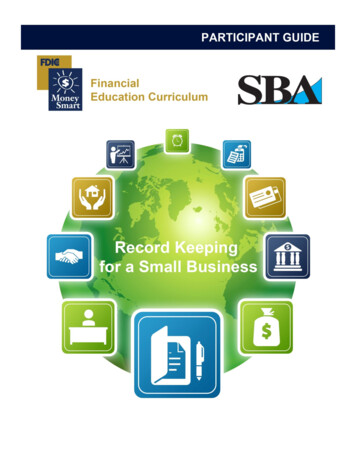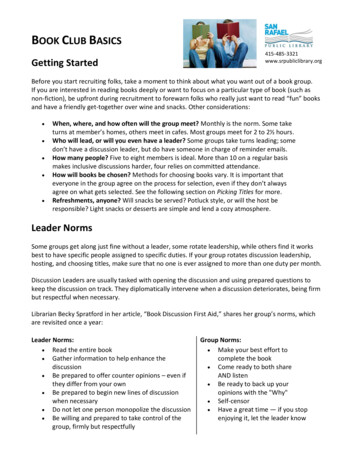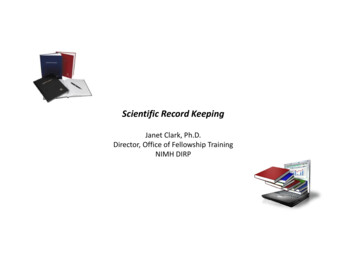
Transcription
GETTING AND KEEPING FATHERSINTERESTED IN YOUR PROGRAMNational Fatherhood Initiative P: 301.948.0599 www.fatherhood.org
Table of ContentsINTRODUCTIONRECRUITBuild a solid foundationGo forth and recruitRETAINCREATE A POSITIVE IMAGE IN THE COMMUNITYCONNECT WITH YOUR COMMUNITYINNOVATE 2018 National Fatherhood Initiativewww.fatherhood.org2
As the nation’s #1 provider offatherhood skill-building programsand resources, National FatherhoodInitiative (NFI) provides guidance forpractitioners and organizations onhow they can create and maintain asuccessful fatherhood program. Fromplanning, to selecting a curriculum,to successfully facilitating your firstsession, we’re here to help you alongthe way so that your program isanother success story.One of the areas that requirescare and attention for a successfulfatherhood program is that ofrecruiting and retaining fathers.Men can be initially reluctant toparticipate in a fatherhood programfor many reasons, whether it beego (e.g. a dad thinks he’s a gooddad already), unavailability (e.g.conflicting work schedule), or theunwillingness to seek help. But thegood news is fathers tell us that afterthey have participated in one of theseprograms, they’re glad they did.So, whether you’re just starting your program to support fathers or are looking for ways to expand anexisting program, we have many proven tactics to help you in your endeavors.In the following sections of this ebook, you’ll learn five keys to enrolling and keeping fathers in yourprogram:1) successful recruitment tactics, 2) successful retention tactics, 3) creating a positive image in yourcommunity, 4) ideas for connecting with your community, and 5) the importance of innovating inthe first four areas. 2018 National Fatherhood Initiativewww.fatherhood.org3
RECRUITThere’s a popular saying that we’re sure you’ve heard: “Build it and they will come.”This saying is sometimes true but oftentimes not realistic, especially when it comes to developing andimplementing a fatherhood program.There are many responsible fatherhood programs with great staff, curriculum, and facilities, but manyof them lack participants. Logic dictates that there isn’t a program without participants to serve.Unfortunately, some staff are very skilled in the business of program operations but don’t know how toget fathers in the door.This section will equip you with the essential tactics you’ll need to begin recruiting for your fatherhoodprogram.Build a Solid FoundationBefore you can begin recruiting fathers to your program, it’s important to havea solid foundation. If you don’t, the whole infrastructure could collapse.Successful recruitment and retention starts and ends not with creativemarketing strategies and tactics, even though they’re important. It startsand ends with getting every staff member and the entire organization behindserving dads. Staff must integrate this service into the organization’s DNA—into every aspect of program and service delivery—by creating a fatherfriendly culture that creates a father-friendly environment that says tofathers, “You’re welcome here.” 2018 National Fatherhood Initiativewww.fatherhood.org4
Here are a few internal “must-have” tactics to build a solid foundation. Commitment from the leadership of your organization. A passionate program director/facilitator who doesn’t mind a bunch of“NOs” and initial failure (e.g. in recruiting fathers). A strategy to deliver your program where fathers are, not just at the location of yourorganization. A willingness to try creative, innovative strategies, and a commitment to measure theireffectiveness. Develop a marketing plan for the short- and long-term. An effective “hook” to recruit fathers, which might have nothing to do with becoming a betterdad. Job training or education services provided in addition to your program, for example, couldbe more attractive for some fathers to initially work with your organization than to participate ina fatherhood program. Schedule program sessions at convenient times for fathers to attend. Implement multiple marketing tactics: Make your program easy for fathers to use and make it accessible. Send messages that motivate fathers and address myths andmisconceptions fathers have about seeking assistance. Help fathers overcome barriers to participation Use credible spokespersons and multiple forms of media to delivermessages to fathers about your program and organization. 2018 National Fatherhood Initiativewww.fatherhood.org5
Go Forth and RecruitNow that you have a solid foundation, you’re ready to recruit fathers. Listedbelow are some tactics that can encourage even the most reluctant fathers toattend and participate. While not an exhaustive list, here are some of the mostcommon tactics used by fatherhood programs. Use tactics that maximize word-of-mouth marketing (e.g. “bring a friend”). After fathers enroll,this kind of advertising will take off. Get referrals from community partners (e.g. Head Start and Early Head Start, government socialservice agencies, faith groups, and schools). Contract to provide your program to fathers served by government agencies (e.g. local healthand human services departments) and other community organizations (e.g. shelters, mentalhealth organizations, and hospitals). Use attractive, attention-getting print materials that appeal to men. Gain access to fathers by going to where they are (e.g. barber shops, sports arenas, andcommunity centers). Target them through businesses frequented by men (e.g. car repair shopsand sporting goods stores). Promote the program with fathers at workplaces. Contact expectant fathers during the prenatal period and immediately after their child is born,the “golden moment” when motivation and interest in parenting is highest and when mothers aremost likely to want fathers’ involvement. Staff the program with men (e.g. as facilitators). Place advertisements in local print and online publications men use. Provide assistance or referrals for issues important to specific groups of fathers (e.g. legalassistance for fathers involved in custody issues). Market the program through well-respected fathers in the community. Use multiple communication mediums (e.g. flyers, email, social media, and mailings). Provide incentives of interest to fathers (e.g. gift certificates for landscaping or hardware andfix-up projects). Serve food at your program sessions and provide child care. Promote that both ofthose incentives will be available. Make the assistance program easy to access (e.g. along a bus or train route). Use positive portrayals of fathers in promotional materials and messages. Use public service announcements (PSAs). Advertise through the local news and radio shows (e.g. stories about fathers transformed by theprogram). 2018 National Fatherhood Initiativewww.fatherhood.org6
Help arrange transportation to program sessions. Choose a comfortable training site. Keep the fee for participation low or free. Have fathers invite neighbors who are fathers. Invite local media to shoot parts of sessions and to conduct interviews of staff and fathers, withfathers’ permission, of course. Don’t call the program a “Father Absence Program” or something similar. Give your program acatchy name—like the 24/7 Dad program—that fathers can relate to and would want to attend. Gather data on program effectiveness to include in promoting the program and help to draw theattention of local media.RETAIN“It’s easier to keep an existing customer happy than to get a new customer.” That’s a classic businessmantra. The same can be said for a fatherhood program. Just because a father comes to the first sessionof your program, it doesn’t mean he’llcome back. So before moving on, we’dlike to share the most critical factors inkeeping fathers coming back.Create a father-friendly organization.Creating an organization with a fatherfriendly environment is the foundationof an effective fatherhood program.Therefore, it’s the first step to keepingfathers in your program. Simplestrategies, such as hanging postersthat show fathers interacting with theirchildren and family, tell fathers that they’re welcome and valued. Please visit our resource store whereyou can order posters like these.You can download our free Father Friendly Check-UpTM to assess how well your organization is set up tosucceed with a fatherhood program. It will also help you create no- and low-cost strategies to make yourorganization and its environment even more father friendly!Contact the father and family prior to the first session. Regardless of the manner in which fathers enter theprogram, if at all possible call or visit the father and the family before the first session. Introduce yourself,talk about the program a little, and discuss some of the concerns the father might express. 2018 National Fatherhood Initiativewww.fatherhood.org7
Here are a few ideas for helping fathers find transportation. Select a site for program sessions that’s accessible to public transportation. Contact the local department of social services, church groups, and volunteer programs forpossible transportation assistance (e.g. staff or volunteers can pick up fathers). Arrange carpooling among program participants. Write a grant to purchase a vehicle staff can use to pick up fathers or to acquire funds that fatherscan use for their own transportation (e.g. bus tokens).Select a convenient, consistent time for each session. Just as scheduling sessions at times that will helprecruit fathers, convenient times will maximize the probability of fathers’ attending on a regular basis. Anearly evening start time during the week or an early morning starting time on the weekend, for example,can increase the probability of fathers’ attendance. Be aware of times when session times conflict withfathers’ other commitments (e.g. sport leagues, self-help support groups, Boy/Girl Scout meetings,church group meetings, etc.) Although eliminating conflicting schedules for every father is unlikely, try tominimize conflicts as best you can.Begin and end on time. Your session times must be consistent and predictable. If the starting time is6:30 p.m., begin at 6:30 p.m., even if only half of the fathers are present. Make every attempt to endthe sessions on time. Transportation schedules, baby sitters, children’s bedtime, and other factorswill be affected should start and end times fluctuate. Choose a comfortable site for the sessions. The facility in which you conduct your sessionsaffects learners. A setting that feels a bit like home promotes a more relaxed group atmospherethan does a traditional classroom setting. Soft or cushioned chairs and a carpeted room with softlighting (but not with overhead fluorescent lights) are more conducive to learning andsharing, and they make the setting father friendly. Have fathers sit in a circle to promote groupcohesion and participation of fathers. 2018 National Fatherhood Initiativewww.fatherhood.org8
Have snacks and beverages. Unless your organization, the facility in which you will conductthe sessions, or funding source prohibits providing snacks and beverages, see to it that thereis plenty to eat and drink. This might sound cliché, but the fastest way to a man’s heart is throughhis stomach. Facilitators of NFI’s fatherhood programs say providing snacks andbeverages is one of the most vital retention and recruitment tools. Snacks and beverages are forfathers to nurture themselves. Fathers with varying degrees of dysfunction often forget or simplydon’t know how to slow down and nurture their body. The offering of snacks and beveragesteaches fathers the importance of nurturing themselves, and that not everything in life needs tobe tense. Make phone numbers and emails of facilitators available to fathers. Unless prohibited by yourorganization or funding source, encourage fathers to call, text, or email if they can’t attend asession. Build a sense of responsibility for their participation in the program. Telling them to call,text, or email if they can’t make a session sends the message to fathers that they’re important andtheir presence is important. The group is not the same without them. It also creates respect for you and the program amongfathers. Tell fathers to enter the phone numbers and email addresses of the facilitators directlyinto their phone. We recommend sharing only your business phone number and email address,not your personal one. Some fathers can develop an extremely strong attachment to a facilitatorsuch that they impose on the facilitator’s personal life. It’s critical that you maintain a boundarywith fathers to prevent this kind of unhealthy attachment from negatively affecting your personallife. Share fathers’ phone numbers and email addresses among group members. Many fathersoften feel that they’re the only ones having difficulty raising their children and establishing apositive relationship with the child’s mother. After they realize that many fathers havethe same problems, they feel a sense of relief and community. Unless prohibited by yourorganization or funding source, enhance these feelings by encouraging fathers to makecontact with one another outside of the sessions by phone, text, or email. Contactamong fathers outside of the group is a good way to share efforts to apply what fathers learn,attempts at behavior management, or some new self-awareness. Such sharing begins to destroyfeelings of isolation and despair that some fathers might experience. Make contact with a father who has missed a session. If a father is absent from a session and hedidn’t contact you ahead of the session to let you know of his absence, contact himafter the session or the next day. Tell him that his absence was obvious and that the groupmissed him. Briefly review what went on during the session, tell him about any assignment for thenext session (e.g. if your program involves homework between sessions), and tell him what he cando to make up a missed session. Scheduling a brief review with the father to get him caught up with the program’s conceptsis important. Sessions in NFI’s 24/7 Dad program, for example, build upon knowledge and skillsin previous sessions, so it’s vital that fathers don’t get behind. Scheduling 30 to 45 minutes beforethe start of the next session to meet with a father who missed the previous session is a soundway to keep him on course. Encourage the father to make contact with other fathers to discusswhat he missed. 2018 National Fatherhood Initiativewww.fatherhood.org9
Establish group rules during the first session. Clear and consistent rules are essential toconducting any group. Fathers will know what to expect (e.g. no cross-talk), and the structure willprovide a sense of individual safety and group security, both essential to encourage fathers’return. Provide group leadership. To gain the respect of fathers, and to cover the content in theprogram, you must clearly exhibit leadership. Fathers will feel comfortable knowing who is incharge. When fathers learn to count on you as the group’s leader, it will be easier for youto hold them accountable to attend regularly. If you will have a co-facilitator, that personmust also exhibit leadership. Praise fathers. Whenever opportunities arise, praise fathers for attending, completing theprogram assignments, attempting new pro-social and pro-fathering behavior, sharingabout themselves (e.g. challenges), etc. Changing specific behaviors and their entire life is oftenscary for fathers, so praise and encourage them often for their effort and accomplishments. Promote respect and dignity among fathers. During their time in the program, fathers mightexperience anxiety and stress about different parts of their lives. They might express theiranxiety and stress in a variety of ways, from simple concerns to full-blown crises.They might say things that seem unrealistic or far-fetched. They might give the impression thatthey have the right solution to addressing their anxiety and stress, even when they don’tIf they feel out of control, they might try to take controlof the group (e.g. bydominating discussions) in an attempt to exercise some control over their life.They might try to develop an unhealthy connection with a facilitator to provide a positivefeeling that counteracts their anxiety and stress. They might use denial, projection, andrationalization as defense mechanisms to prevent you and others from “getting in.” Regardless ofhow fathers express their anxiety and stress, remember this vital point: As a facilitator,your responsibility is to model and promote respect and dignity for all of the fathers. The positiveactions you take will go a long way to enhancing cohesion, expressiveness, and support within thegroup, three group dynamics that will keep fathers coming back.A few final tips. 2018 National Fatherhood Initiativewww.fatherhood.org10
Don’t allow new fathers into the group after the responsible fatherhood program starts, knownas “closed enrollment.” Research shows that this form of enrollment increases program impactcompared to adding fathers at any time during the program, known as “open enrollment.” Avoid “cutting fathers down,” making snide remarks, and taking a father’s side during adisagreement he has with another father(s). If a father has a caseworker, make contact with the caseworker to discuss how each of you ishelping the father and how you can support each other’s work with him. Keep in mind, of course,commitments of confidentiality you might be required to maintain. If any fathers come from cultures with which you aren’t familiar, they might have learneddifferent approaches to fathering and parenting that you might not expect. Be tolerant of thesedifferences, not critical. It’s wise to talk with such fathers prior to their entering the program as away to understand these differences and how they will affect the delivery of yourprogram’s content. If a father says during group something like, “I’m going to tell you (the facilitator or the group)something if you promise not to tell anyone,” make no such promise. Tell the father that you willdiscuss the issue in private and only after the session ends. If the father is a teen, you might have to visit with his parents or the parents of the mother (thegrandparents) because one or both teen parents might be living with the grandparents. Informthem about the program and the importance of the father’s consistent attendance.There’s a popular saying that we’re sure you’ve heard:“Build it and they will come.”This saying is sometimes true but often times not realistic, especially when it comes to developing andimplementing a fatherhood program. 2018 National Fatherhood Initiativewww.fatherhood.org11
There are many responsible fatherhood programs with great staff, curriculum, and facilities, but manyof them lack participants. Logic dictates that there isn’t a program without participants to serve.Unfortunately, some staff are very skilled in the business of program operations but don’t know how toget fathers in the door.This section will equip you with the essential tactics you’ll need to begin recruiting for yourfatherhood program.Creating a positive image in your community is essential to your program’s success. It will help youcreate a strong referral network. Next to word-of-mouth advertising, a strong referral network is the mostimportant recruitment tactic. Current and potential referral sources will be more likely to trust you andyour organization if they continually hear positive stories about the impact of your fatherhood programspecifically and organization generally.Remember that you represent your fatherhood program and organization. You and others associated withyour program are often the first impression community members will have about your program. Beyondbeing professional, here are a few other tips on how you and others associated with your program canhelp create a positive image in the community. Create productive, reciprocal relationships with community organizations. If you ask them torefer fathers to you, ask what you can do for them in return. Use child-centered messages. Promote the positive impact and benefits of the program and ofinvolved fathers for children. Organize Father’s Day events and other celebrations of fatherhood. Sponsor events that focus on father-child activities. Encourage participants to get involved in the community and promote the fatherhood program. Create media opportunities that present the program and fathers in a positive light. Become a resource of fatherhood information for the media and other community organizations. If there are other fatherhood programs in your community, establish relationships with them toeliminate “turfism.”Given that the foundation for creating a positive image is developing a strong referral network ofcommunity organizations, you might wonder where to start. To create such a network, start byidentifying a staff person(s) who will be responsible to reach out to, meet with, and maintain giventhat the foundation for creating a positive image is developing a strong referral network of communityorganizations, you might wonder where to start. To create such a network, start by identifying a staffperson(s) who will be responsible to reach out to, meet with, and maintain regular contact with othercommunity organizations and partners about your program. One-time contact won’t generate the longlasting connections you need. 2018 National Fatherhood Initiativewww.fatherhood.org12
Start to develop this network before you launch your program. Doing so will give you the nascent networkyou need to generate initial referrals and increase your success in getting your program off on the rightfoot. But like most of things we’ve shared here, success in developing this network takes some planning,follow through, and rigorous management to identify who you will contact, what messages you’ll deliverabout your program, and how often you’ll follow up to remind organizations about it and inform them ofprogram developments (e.g. changes and successes).CONNECT WITH YOUR COMMUNITYGiving fathers and mothers an opportunity tovoice their concerns will help alleviate some oftheir fears. Furthermore, fathers will feel morecomfortable walking into the first sessionknowing they’ve had some contact with you. Ifyou will have a co-facilitator, they shouldparticipate in this visit, too.Help arrange transportation when necessary.Fathers can’t attend the program if they can’t getto program sessions. Transportation will be a bigproblem for some fathers. Lack of a car and thecost of using public transportation, a cab, or a rideshare—not to mention gasoline and parking—can prevent some fathers from attending. It’s not unusualto find that the fathers who can’t get transportation are the fathers who would profit the most fromparticipating in the program.There is a slew of possible community partners. But there are many types of possible partnerscommon to many communities. During the 2017 Texas Fatherhood Summit, which was attended bystaff from seasoned fatherhood programs across the state, attendees generated the list below. 2018 National Fatherhood Initiativewww.fatherhood.org13
Social service programs of government agencies at the federal, state, and local levels(city and county) Courts, and court-appointed programs Workforce commission/career development/workforce centers Alcoholics Anonymous and other rehabilitation programs State/County home visiting programs Healthcare organizations (e.g. pregnancy centers and health clinics) Schools, colleges/universities Parole officers Reentry programs WIC/SNAP offices Housing authorities Community Coalitions and Community Action Agencies Chamber of Commerce, Rotary Clubs Local University Extension Office(s) that often have daycare or family programs Churches Head Start and child care Locations Parent Teacher Associations (PTA) Libraries YMCA, Boys and Girls Clubs Salvation ArmyDevelop a list for your own community. Follow these tips for honing that list to the most effectiveorganizations to include in your referral network: Don’t bite off more organizations than you can chew. Think about which ones are most likely toserve the kind of father(s) you currently serve or want to serve. Pick a few that you think will be a good fit and prioritize them for contact. Test your messages and tactics for generating referrals with those few. Refine your messages and tactics based on the reaction of those few and the referrals theygenerate. Rinse and repeat until you get it right. Expand your referral network after you learn what works and what doesn’t. 2018 National Fatherhood Initiativewww.fatherhood.org14
INNOVATEWhen it comes to recruiting fathers, we encourage you to be innovative in your efforts. Be bold.Implement creative ideas to recruit and retain fathers in your program, create a positive image in thecommunity, and connect with your community.Don’t be afraid to step outside of the box. Look for what other social service organizations with a differentfocus have done to successfully engage their populations of interest in their programs and services and toinfluence behavior change. You can even look at the success of marketing efforts by organizations in otherindustries.As such, here are two innovative and creative ideas to recruit and retain dads that are based on researchin the social sciences about what works to influence behavior change.Idea 1: Cues, Triggers, and NudgesBy understanding cues, triggers and nudges, you can get fathers to habituallyparticipate in a service, workshop, or program as well as help fathers developthe habits of good fathering above and beyond reliance on the resources (e.g.programs/curricula) you might currently use. Cues are stimuli in the environment that lead to developing a routine that is the basis for a habit.On the other side of the routine is a reward. (Cues, routines, and rewards go hand in hand increating a habit.) Charles Duhigg in The Power of Habit describes the research on the power ofhabits and the role that cues perform in creating them. 2018 National Fatherhood Initiativewww.fatherhood.org15
Triggers are, quite simply, reminders to engage in a specific behavior. They help generate moreword-of-mouth advertising, which is the most impactful form of advertising for a fatherhoodprogram. Jonah Berger in Contagious describes the research on the role that triggers play inkeeping behaviors top of mind (e.g. attending a fatherhood program) and in generatingword-of-mouth (e.g. advertising a fatherhood program). Nudges are small changes in the world around us (environment) that influence us to make betterdecisions. A nudge is not an economic incentive in which choice is eliminated (e.g. a father whoowes child support will go to jail if he doesn’t attend a fatherhood program—a hammer, not anudge).Here is a list of ideas for integrating cues, triggers, and nudges that could helpyou address two major pain points in fatherhood programming—retention offathers and consistent involvement of fathers in their children’s lives. Think ofways in which you could apply these ideas to each pain point. Direct fathers to select an easy, frequent, strong (obvious) cue and a powerful reward for themto engage in the behavior (regular attendance or consistent involvement in their child’s life) thatdoesn’t exist in their environment. Choose a cue that is customized to each father’s circumstances(e.g. access to his children) and a reward that is, ideally, emotional so that it will stand a goodchance of reinforcing the behavior every time he engages in it. Help your fatherhood group select a cue and reward that doesn’t exist in the fathers’environments and that all of them can implement. Each father can report at the start or end ofeach session on how well the cue and reward worked in helping him engage in the behavior. Help fathers identify bad habits that keep them from engaging in the behavior. This identificationwill involve naming the cues, routines (behaviors), and rewards for these bad habits. Researchshows that you should focus on changing the behavior (routine) when trying to changea bad habit rather than trying to change the cue or reward. This idea involves identifyinga competing habit (cue-routine/behavior-reward system) that keeps fathers from regularattendance or consistent involvement in the life of their child. Help fathers see how they canrespond to the cue with the behavior you want them to engage in (rather than thecompeting behavior) and how the new behavior can be reinforced by the same reward. In between sessions, call or send email or text reminders to specific fathers or the entire groupas a trigger (reminder) to attend the next session or engage in a specificaction of involvement intheir children’s lives. This idea will keep the behavior “top of mind.” Consider asking eachfather at the end of his time with the group, for example, to identify a specific action he will taketo be involved in his child’s life before the group sees him again. Send an email or textreminder, one or more times, to take that action before the group sees him again. Create a “buzz” around your program by getting graduates (alumni) to generate “ongoing” wordof-mouth advertising by talking with potential participants about howmuch they loved/benefitedfrom it. 2018 National Fatherhood Initiativewww.fatherhood.org16
Link the behavior to a frequent trigger that already exists in a fathers’ environments. Considerwhat fathers do on an everyday or almost everyday basis. Could you, for example, create a simplereminder card or magnet fathers could attach to their bathroom mirror so that every timethey shave they’re reminded to attend the next program session? Link the behavior to a trigger that happens near where the behavior will or should take place. Iffathers receive a service or participate in ano
So, whether you’re just starting your program to support fathers or are looking for ways to expand an existing program, we have many proven tactics to help you in your endeavors. In the following sections of this ebook, you’ll










